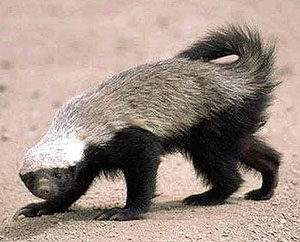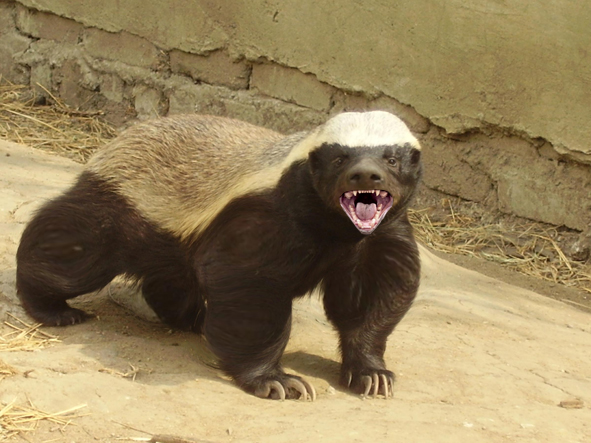 Fun Facts about Honey Badgers!
Fun Facts about Honey Badgers!
Most fearless animal in the world
The honey badger is also known as the ratel and is native to Africa and Southwest Asia. They belong to the same family class as the weasel, which makes them a member of the Mustelidae family.
The honey badger has quite a reputation as a fearless animal, they have been known to chase away young lions and take their food.
In 2002 the Guinness Book of Records, declared the Honey Badger the "most fearless animal in the world”. It is primarily a carnivorous species and has few natural predators because of its thick skin and ferocious defensive abilities.
Honey badgers are also basically solitary creatures. They will kill and eat snakes, including poisonous or large snakes such as cobras. The honey badger is not particularly fussy when it comes to food they have been known to dig up human corpses in India. Honey badgers are also able to feed on something as tough as a tortoise without any difficulty, due to their powerful jaws and claws.
Not only is the honey badger fearless, but they are also intelligent animals and are one of a few species known to be capable of using tools. The Honey Badger has been observed rolling a log over to the entrance of a cave where he stood on the log to capture a bird that was stuck. The honey badger has a fairly long body, and a thick skin around the neck, an adaptation for fighting. The head is small and flat, with a short muzzle. The eyes are small, and the ears are little more than ridges on the skin, another possible adaptation to avoiding damage while fighting.

- It said that the only safe grip on Honey Badger is on its back of the neck.
- Honey badgers are jet black except for the gray mantle, separated by a white stripe, extending from the crown to the base of the tail. The color of the mantle and stripe may vary from one individual to another and often becomes darker with age.
- The honey badger is also known as the ratel. The Norwegian for honey badger is Honninggraevling, and the French is le blaireau mange-miel. In those parts of Africa where Swahili is spoken, the honey badger is called Nyegere.
- Honey Badgers hunt at any time of the day, but become nocturnal in places with high human populations.
- Honey Badgers are able to dig quickly into the hard earth, they can dig a hole deep enough to hide themselves.
- A Honey Badger's baby is called a ‘kit’. The females are called ‘sow’ and males ‘boar’. Honey Badger group is called a ‘cete, colony, set or company’.
- A fully grown adult male can stand as high as 30cm, and be up to 1m in total length.
- They are normally solitary animals, and are one of the lesser seen African mammals.
- They have skin which is very thick and rubbery, to defend them from bites, and they are able to catch and eat even the most deadliest and poisonous snakes.
- Honey Badgers get their name from their love of honey, they seek out not only the honey but also the bee larvae.
- Honey badgers have a unique relationship with the greater honey guide. The little bird leads a honey badger to a beehive, and then waits good-naturedly for the honey badger to open up the hive and enjoy the honey and bee larvae. Once the honey badger leaves the hive, the honey guide will then feed on the remaining beeswax.
- There is just one species of honey badger, Mellivora capensis.
- Litters of 1-2 young are born in nursery dens lined with grass. A young honey badger reaches adult size at around 8 months of age, but stays with its mother until is at least 14 months of age.
- Honey badgers can be very aggressive animals, and have few predators.
- Honey badgers can produce offensive secretions from their anal glands
- One method Honey Badgers use when attacking larger prey (including humans) is to castrate them and then wait for the animal to weaken or die.
- Honey badgers have been known to attacked animals as large as sheep, horses, buffaloes, wildebeest and waterbuck.
- The badgers striking colouration makes them easily recognizable and they could only be confused with the much smaller Striped polecat (Ictonyx striatus) and Striped weasel (Poecilogale albinucha).
- Honey badgers have a distinctive jog-trot.
- Sadly, Honey Badgers are near threatened in South Africa due to attacks by bee- keepers, poultry and sheep farmers.
- The South African Defense Force named their Infantry Fighting Vehicle (IFV), the Ratel, after the Honey Badger.
- A female honey badger has a home range of 100-150 square km.
- The voice of the honey badger is a hoarse "khrya-ya-ya-ya" sound. When mating, males emit loud grunting sounds
- When attacked by dogs, Honey Badgers scream like bear cubs.
- The honey badger does not have visible ears.
- Honey badgers are accomplished climbers and can easily climb up into the uppermost branches of trees to raid bird nests or bee hives.
- Pale chanting- goshawks have been observed following honey badgers.The badgers are powerful, prolific diggers and repeatedly flush rodents and reptiles from their underground refuges, ideal prey for the goshawks.
Sources:
http://www.badgers.org.uk
http://en.wikipedia.org/wiki/Honey_badger
http://www.youtube.com/watch?v=YBqKTiEvGAM (Honey Badger using tools)
http://www.wild-facts.com/2010/wild-fact-724-the-world-record-holder-honey-badger/